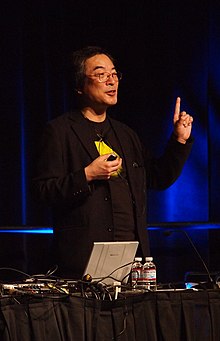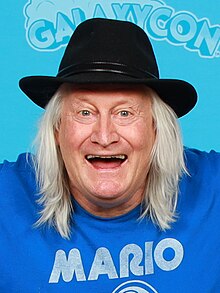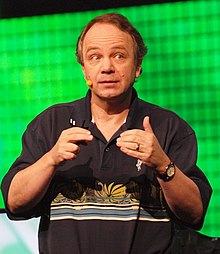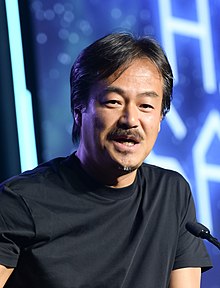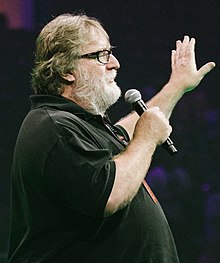Portal:Video games
The Video Games Portal

A video game', sometimes more specifically computer game,' or more ambiguously just game, is an electronic game that involves interaction with a user interface or input device (such as a joystick, controller, keyboard, or motion sensing device) to affect computation and data access processing game logic as part of a simulation to ultimately generate visual feedback from a display device, most commonly shown in a video format on a television set, computer monitor, flat-panel display or touchscreen on handheld devices, or a virtual reality headset. Sections of interaction may be interspersed with non-interactive (usually story-based) portions (e.g., cutscenes). Most modern video games are audiovisual, with audio complement delivered through speakers or headphones, and sometimes also with other types of sensory feedback (e.g., haptic technology that provides tactile sensations). Some online video games also allow microphone and webcam inputs for in-game chatting and livestreaming.
Video games are typically categorized according to their hardware platform, which traditionally includes arcade games, console games, and PC games; further, the latter encompasses LAN games, online games, and browser games. More recently, the video game industry has expanded onto mobile gaming through mobile devices (such as smartphones and tablet computers), virtual and augmented reality systems, and remote cloud gaming. Video games are also classified into a wide range of genres based on their style of gameplay and target audience. The scope of development is another categorization, from AAA titles to indie games. (Full article...)
Featured articles –
Lego Star Wars II was critically and commercially successful; it has sold over 8.2 million copies worldwide as of May 2009. Critics praised the game for its comedic and "adorable" portrayal of the film series and due to preference for the original trilogy over the prequel trilogy. However, the game's low difficulty, and its Game Boy Advance and Nintendo DS versions in general, were received more poorly. The game received awards from the British Academy of Film and Television Arts and Spike TV, among others. A mobile phone adaptation, Lego Star Wars II Mobile, was later developed by Universomo, published by THQ, and released on 5 January 2007. Lego Star Wars II and its predecessor were compiled in Lego Star Wars: The Complete Saga, released much later that year. (Full article...)
BioShock's concept was developed by Irrational's creative lead, Ken Levine, and incorporates ideas by 20th century dystopian and utopian thinkers such as Ayn Rand, George Orwell, and Aldous Huxley, as well as historical figures such as John D. Rockefeller Jr. and Walt Disney. The game includes role-playing elements, giving the player different approaches in engaging enemies such as by stealth, as well as moral choices of saving or killing characters. Additionally, the game borrows concepts from the survival horror genre, notably the Resident Evil series. BioShock is considered a spiritual successor to the System Shock series, on which many of Irrational's team, including Levine, had worked previously.
BioShock received universal acclaim and was particularly praised by critics for its narrative, themes, visual design, setting, and gameplay. It is considered to be one of the greatest video games ever made and a demonstration of video games as an art form. BioShock was followed by two sequels, BioShock 2 and BioShock Infinite, released in 2010 and 2013, respectively. Ports of BioShock were released for macOS and mobile following its console releases. A remastered version of the game was released on Microsoft Windows, PlayStation 4, Xbox One, and Nintendo Switch as part of BioShock: The Collection. (Full article...)
Computer Space is a space combat arcade video game released in 1971. Created by Nolan Bushnell and Ted Dabney in partnership as Syzygy Engineering, it was the first arcade video game as well as the first commercially available video game. Computer Space is a derivative of the 1962 computer game Spacewar!, which is possibly the first video game to spread to multiple computer installations. It features a rocket controlled by the player engaged in a missile battle with a pair of hardware-controlled flying saucers set against a starfield background. The goal is to score more hits than the enemy spaceships within a set time period, which awards a free round of gameplay. The game is enclosed in a custom fiberglass cabinet, which Bushnell designed to look futuristic.
Bushnell and Dabney designed the game in 1970–71 to be a coin-operated version of Spacewar!. After the pair were unable to find a way to economically run the game on a minicomputer such as the Data General Nova, they hit upon the idea of instead replacing the central computer with custom-designed hardware created to run just that game. While they were working on an early proof of concept, Bushnell found a manufacturer for the game in Nutting Associates. Working in partnership with Nutting, the pair completed the game and ran their first location test in August 1971, a few months prior to the display of a similar prototype called Galaxy Game, also based on Spacewar!. It was first shown to industry press and distributors at the annual Music Operators of America (MOA) Expo in October. With encouraging initial interest, though mixed responses from distributors, Nutting ordered an initial production run of 1,500 units, anticipating a hit game.
While the game was successful and validated Syzygy's belief in the future of arcade video games, selling over 1,000 cabinets by mid-1972 and ultimately 1,300–1,500 units, it was not the runaway success that Nutting had hoped for. The game spawned one clone game, Star Trek (1972), and Nutting produced a two-player version of Computer Space in 1973 without involvement from Bushnell and Dabney. The pair left Nutting in June 1972 and incorporated Syzygy as Atari, launching the successful Pong (1972) as their next arcade game. Computer Space's release marked the ending of the early history of video games and the start of the commercial video game industry. (Full article...)
The game was developed rather quickly as a sequel to the Nintendo 64 title Hey You, Pikachu! and to promote the Nintendo e-Reader accessory, and uses a novel 3D texturing effect. It was first showcased at Electronic Entertainment Expo (E3) 2003 and later through a month-long series of promotional events in Sapporo, Hokkaido, Japan. It was released on July 18, 2003, in Japan, December 1 in North America, and April 2, 2004, in Europe. In Japan, the game sold 66,373 copies in its first year. It received mixed reviews, which generally criticized its low level of interactivity and repetitive sound effects, though its collecting aspects and visuals were somewhat better received. (Full article...)
The idea for Untitled Goose Game originated from a stock photograph of a goose that a House House employee posted in the company's internal communications. Inspired by Super Mario 64 and the Hitman series, House House worked on combining stealth mechanics with a lack of violence to create humorous in-game scenarios. The game's unusual name came from a last-minute decision in preparing the title as an entry for a games festival. The music, curated by composer Dan Golding, uses short clips from six of Claude Debussy's Préludes. It has been described as "reactive music" because the clips are played after certain actions. The game was released on macOS, Nintendo Switch, and Windows on 20 September 2019, and PlayStation 4 and Xbox One on 17 December 2019.
Untitled Goose Game received positive reviews, with critics praising its gameplay and humour. The game received the D.I.C.E. Award for Game of the Year and the Game Developers Choice Award for Game of the Year, among other accolades. Dan Golding was nominated for an ARIA award for the music. By the end of 2019, Untitled Goose Game had sold more than a million copies. (Full article...)
Lightning was created by Motomu Toriyama, the director and scenario writer of XIII, and designed by regular Final Fantasy artist Tetsuya Nomura. The design goal was a character who was less feminine than previous Final Fantasy heroines in both appearance and personality. Aspects of her early design and personality were later altered, or transferred to other characters. After XIII, Lightning's design was revised several times to reflect her role and development in each game, particularly in Lightning Returns. Her real name in Japanese, Éclair Farron, was originally a placeholder. Because of her first name's association with a type of pastry, it was changed to "Claire" in other countries.
Lightning has received mixed commentary from critics—much of it relating to her cold personality, which was compared to that of Final Fantasy VIIs protagonist Cloud Strife. She was criticized for her relative absence in XIII-2. Her role in Lightning Returns met with mixed reception: some critics saw her as underdeveloped and unlikable, while others found her better developed and more human than in previous games. Lightning later appeared on lists, compiled by video game publications, of the best characters in the Final Fantasy series and in video games as a whole. She has been received favorably in polls of public opinion by Famitsu, Square Enix, and other organizations. ('Full article...)
Did you know... -
- ... that Through the Darkest of Times was the first video game published in Germany to use swastikas?
- ... that the game designer of the video game Hades said that the characters were attractive "because Jen Zee"?
- ... that a pink skin for Mercy in the video game Overwatch helped raise more than $12 million for breast cancer research?
- ... that Rawson Stovall became the first nationally syndicated video game journalist in the United States when he was only eleven years old?
- ... that the team developing the action video game Knights Contract researched European folklore on witches and witch hunts?
- ... that Kainé from the video game series Nier was created in response to a female staff member's vague wish for a "male heroine"?
- ... that the 1987 video game Oriental Hero was panned as "so incredibly bad it's almost worth a look"?
- ... that the urban legend Herobrine was ranked on a Guinness World Records poll of the best video game villains, despite never existing?
- ... that the name of the video game mod series Bomba Patch was inspired by éclairs?
- ... that the character Psycho Mantis in the video game Metal Gear Solid breaks the fourth wall by identifying the player's other games?
- ... that a reviewer thought that the video game Robbery Bob contained cringeworthy dialogue?
- ... that the contrabass trombone has experienced a revival in film music and video game soundtracks?
Selected biography –
Selected image -
Recent video game-related events
- September 12, 2024 – 2023–2024 video game industry layoffs
- Microsoft announces that it will lay off 650 Microsoft Gaming employees as part of cuts to its workforce. (Variety)
- August 15, 2024 –
- American video game magazine Game Informer discontinues publication after 33 years. The magazine's website is also shut down. (BBC News)
- May 24, 2024 – Uvalde school shooting
- Families in Uvalde, Texas, U.S., file a lawsuit against Daniel Defense and Activision Blizzard for creating the DDM4 V7 gun and promoting the weapon through the game Call of Duty, respectively. They also sue Meta Platforms for owning Instagram, which was used by the gunman. (AP)
Topics
Categories
Things you can do
Summary of Video games WikiProject open tasks
| |
|
AfDs
Merge discussions
|
Other discussions
No major discussions
Good article nominations
DYK nominations
No did you know nominations
|
Articles that need...
| |
In other Wikimedia projects
The following Wikimedia Foundation sister projects provide more on this subject:
-
Commons
Free media repository -
Wikibooks
Free textbooks and manuals -
Wikidata
Free knowledge base -
Wikinews
Free-content news -
Wikiquote
Collection of quotations -
Wikisource
Free-content library -
Wikiversity
Free learning tools -
Wiktionary
Dictionary and thesaurus










